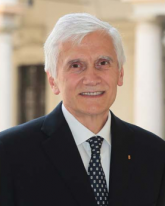Without access to treatment, can we truly innovate in rare diseases?

Interview with Giampaolo Merlini
There have been many developments on rare diseases since the EU Orphan Medicinal Products Regulation came into force in 2000. As the European Commission is evaluating its effectiveness, EHA discussed with Prof. Giampaolo Merlini, Director of the Amyloidosis Research and Treatment Center and researcher at the Department of Molecular Medicine of the University of Pavia, how far we have come and what still needs to be done to improve access to treatment for rare diseases.
Prof. Merlini, could you briefly explain what are rare diseases and the challenges they pose?

The definition of rare diseases varies depending on the country or region. In the European Union, diseases affecting less than five persons in 10,000 are considered rare. Almost 7,000 rare diseases have been identified to this day, including in hematology, and would concern between 6% and 8% of the overall EU population.
The efficacy of treatment depends on time and diagnosis; this is true for any condition. But because they are so uncommon, the first challenge of rare diseases is diagnosis. Many are complex and progressive, which makes it difficult to recognize them early on and to provide care to patients. This is all the more crucial in the case of life-threatening diseases, where time is precious.
Another major issue is the availability of effective treatments, also referred to as orphan drugs. Drug development for rare diseases is more challenging as the patient population is smaller. That means rarer candidates for clinical trials, lengthier processes for coming up with the right medicine for a specific condition, and costlier treatments for patients.
Why is it so crucial to tackle rare diseases?
First, taken collectively rare disorders are fairly common, affecting about 30 million people in the European Union. So, they constitute an important social and medical need. Second, research on rare diseases can benefit a much broader population as these conditions may display similarities with more common diseases.
Could you give an example?
Well, take amyloidoses, for instance. They are rare conditions. Nonetheless, their pathogenic characteristics and inner mechanisms are akin to Alzheimer’s disease. Deepening our understanding of systemic amyloidosis could support research and care for Alzheimer’s disease, a condition that concerns over 7.5 million people in Europe alone[1].
How would you evaluate the progress in tackling rare diseases? Are we doing enough?
We have seen a lot of progress on rare diseases, particularly in Europe. The European Union has made tremendous efforts, since the Orphan Medicinal Products Regulation, fostering research and innovation in orphan drugs and setting a solid network of centers of excellence – through the European Reference Networks (ERNs) such as EuroBloodNet and EUnetHTA. This regulatory framework has proven instrumental in improving patient care.
Nonetheless, there is still a lot to do. Although we have seen a large increase in treatments for rare diseases, the level of unmet needs remains high and no medicines exist for a majority of rare conditions. That is why we must keep on fostering research, both basic and translational, on rare diseases.
Besides, new orphan drugs do not necessarily mean patients benefit from them, and this for various reasons. Should we consider it true innovation if the medicine is inaccessible?
Lastly, progress on rare diseases has been uneven across the world. Regions such as Latin America, Africa and the Middle and Far East are lagging behind and could benefit from greater support. To get a real sense of the scale of rare diseases and speed up clinical research, we need to take a global view on them.
You make a clear distinction between orphan drug innovation and patient access. What are the main hurdles to access to treatment for rare diseases?
Several obstacles deserve the attention of the health community – from regulators to patients, from pharmaceutical companies to doctors – if we want to make a difference for patients.
First, awareness and information exchange. There is a strong need to facilitate information exchange between centers of excellence. The launch of the European Platform on Rare Disease Registration in February this year was a good step in that direction, as doctors will be entitled to monitor the efficacy and potential toxicity of treatments more easily. We now need to build up new knowledge about those diseases for better patient care.
Second, pricing. Orphan drugs are particularly expensive, and healthcare systems may not always have the resources and structures to implement reimbursement schemes, thus limiting market access. High prices remain one of the most significant access barriers for patients.
Speaking of pricing, orphan drugs are often said to be expensive because the patient population is small; and the more “exclusive” the treatment, the higher the cost. Is that an insoluble conundrum?
Perhaps not. It is true that orphan drugs are more expensive to develop and that the return on investment for pharmaceutical companies would be lower. However, prices need to reflect a good balance between the real cost and the value of medicines.
Value should be determined, through Health Technology Assessment, based on the overall benefit of the drug, not only as a treatment or cure for a specific disease, but also as a relevant step in advancing research on other pathologies (including common diseases). Drug development furthers our understanding of diseases and health mechanisms. This is why we need to take a broader perspective to acknowledge the role of orphan drugs in overall health R&I.
Another part of the solution is fair pricing. National health and reimbursement policies create discrepancies, as patients from different countries will not have access to the same medicines. Yet, patients could benefit from greater cooperation on that level. The Beneluxa initiative is a good example of collaboration between Belgium, the Netherlands, Luxembourg, Austria and Ireland for negotiating the price of orphan medicinal products.
Beyond fair pricing, what still needs to be done to improve access to treatment for rare diseases?
All stakeholders of the health community and regulators have a role to play in improving access to treatment for rare diseases.
Patient organizations and doctors should raise awareness about rare diseases and unmet needs. In particular, doctors need to advocate more actively for fair access to drugs, from the very moment of clinical trials onwards. Healthcare professionals should contribute to assessing the value of orphan drugs on the long term, through registries, together with pharmaceutical companies and regulators.
Policymakers, on their end, need to further facilitate exchanges between centers of excellence, as well as knowledge sharing from R&I projects. In addition, we need to foster a new approach to clinical trials for rare diseases, with innovative design, shorter processes and quicker market access.
We need to, collectively, put more efforts into securing affordable and sustainable access to treatment for rare diseases.
[1] Eurostat data, 2013.



 Back
Back